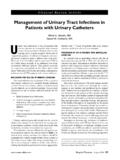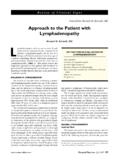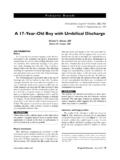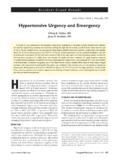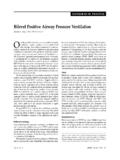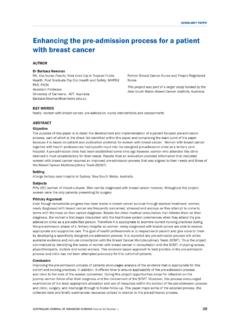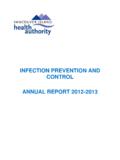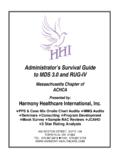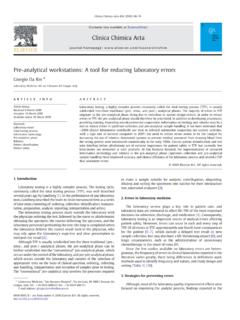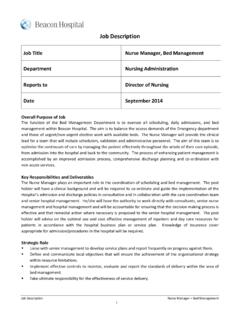Transcription of Implementation of a System-Wide Quality …
1 Vol. 18, No. 6 June 2011 JCOM 253 RepoRts fRom the fieldAbstract Objective: To describe a hospital and health sys-tem wide continuous Quality improvement project to improve early detection, treatment, and prevention of delirium. Methods: Protocols were pilot tested then built into daily work processes for all hospitalized medical-surgical patients. All patients admitted to the Acute Care for Elders unit were included in the pilot (n = 102 pre-protocol, n = 97 post-protocol). Results: After implementing the protocols, there was a significant reduction in average length of stay for patients with delirium ( days pre versus days post). Decreases were also seen in rates of death (23% vs ), ICU transfers (18% vs 0%), and 30-day readmissions (31% vs 5%). Conclusions: Implementation of delirium prevention and treatment protocols can decrease the incidence and negative consequences of delirium in the acute care hospital.
2 These protocols are easily incorpo-rated into daily work is an acute, fluctuating disturbance of con-sciousness, attention, cognition, and perception that can affect sleep, psychomotor activity, and emo-tions. It is the most common psychiatric syndrome seen in the hospital setting, affecting up to 20% of elderly patients, with even higher rates found on intensive care units (ICUs) and oncology and surgical wards [1,2]. Patients who develop delirium have higher rates of morbidity and mortality, rates comparable to those seen in patients with sepsis or myocar-dial infarction [1,3]. They also have longer hospital stays and higher rates of posthospital institutional care [4,5]. Delirium can be prevented. Studies have shown that the incidence of delirium can be reduced by a third through avoiding sleep deprivation, enhancing mobility, addressing visual and hearing impairments, avoiding dehydration, and cognitively stimulating at-risk elderly patients [6].
3 When the avoidance of medications precipitating delirium is part of the prevention protocol, delirium can be decreased by more than half [7]. If delirium does develop, early recognition and prompt identification of the underlying cause may decrease severity and associated morbidity [8]. Summa Health system (SHS) is one of the largest inte-grated health care delivery systems in Ohio with over 2000 licensed beds, 6 community hospitals, 4 community health centers, 10,000 employees, and its own health plan. SHS maintains a strong commitment to patient safety and qual-ity. In 2007, the division of geriatric medicine approached the patient safety committee with a concern about the incidence and underrecognition of delirium by nursing and medical staff. An audit revealed that delirium was being identified by the primary care team only 30% of the time compared to what was documented by the inpatient geriatric consult service.
4 Although SHS had an Acute Care for Elders (ACE) unit [9] that employed a guideline for the prevention and treatment of delirium, the guideline was not regularly used in the unit or available outside the unit. After a presentation demonstrating the poor outcomes and increased resource consumption associated with delirium and evidence show-ing the effectiveness of prevention practices, the patient safety committee decided to make prevention and treatment of delirium a key clinical Quality improvement project for the system . This paper describes the Implementation and outcomes of our project. the ABCs of Implementation A: AgreeAfter endorsement by the patient safety committee, the next step was to obtain agreement among stakeholders. To achieve this, a steering group was assembled whose mem-bership included senior management, board members, phy-sician leadership, the vice president of medical affairs, key Implementation of a System-Wide Quality Improvement Project to Prevent Delirium in Hospitalized Patients Kyle R.
5 Allen, DO, Susan M. Fosnight, RPh, BCPS, CGP, Rex Wilford, DO, RPh, Lyn M. Benedict, MSN, RN-BC, CNS, CDP, Allison Sabo, Carolyn Holder, MSN, RN, GCNS-BC, Donald S. Jackovitz, MS, CPHQ, Sandra A. Germano, BSN, RN, Linda Gleespen, BSN, RN, Elizabeth Baum, MD, CMD, Scott T. Wilber, MD, MPH, and Susan Hazelett, RN, MSFrom the Summa Health system , Akron, JCOM June 2011 Vol. 18, No. 6 pReventiondepartment chairs, senior and mid management nursing leadership, laboratory, pharmacy, and emergency medicine leadership, and Quality office personnel. A 1-hour kickoff presentation made to the steering committee by the chief of geriatric medicine and leader of the delirium prevention and treatment project provided background information on delirium, barriers to detection and treatment, and the poor outcomes associated with the condition.
6 A multidisciplinary task force from the division of geriatric medicine had previ-ously outlined a strategy for improvement and identified potential outcomes that could result from an improvement plan. The presentation secured buy-in from the top down and was key to obtaining the agreement of those who would be needed to participate in and provide support for the : BuildOnce the Agree phase was completed and there was assur-ance of widespread support, a multidisciplinary delirium workgroup was established that included physician lead-ership from medicine, neurology, geropsychiatry, geriat-ric medicine, emergency medicine, and surgery; nursing leadership from the ACE unit, including advance practice nursing and staff nurses; medical, surgical, emergency department, and behavioral health staff nurses; and so-cial work.
7 The team also included the director of hospital Quality , nurse Quality management and leadership, nurses from clinical informatics, geriatric pharmacy, and geriatric medicine fellows. The geriatrics department provided the chair and facilitation leadership for this group along with the Quality office. The group met monthly over about half a year to outline the scope of work, define outcome measures, discuss how to integrate screening and monitoring into daily nursing work flow, and devise a computerized physician order set for the management of delirium, including diagnostic workup and medication management protocols for anti-psychotic use. Key objectives were to develop protocols to identify patients at risk for delirium, to implement evidence-based measures to decrease the incidence of this syndrome, and to develop a standardized treatment inter-vention for active delirium.
8 The workgroup reviewed the literature to identify practi-cal and validated delirium screening and diagnostic tools. The emergency medicine research center at SHS had been evaluating cognitive screening tools for use in the ED and had participated in testing and validating the Six-Item Screener (SIS) [10] to detect cognitive impairment in ED patients. The SIS has a sensitivity of 69% to 94% and a specificity of 81% to 86% for detecting cognitive impairment when compared with a structured diagnostic clinical assess-ment in community-dwelling elderly African Americans and patients referred to an Alzheimer s clinic [10]. A group of medical-surgical nurses pilot tested the SIS, and the SIS was found to be acceptable for use in our system . In addi-tion, prior research at our institution [11] had shown that a positive answer to the admission assessment question have you been confused in prior hospitalizations was a strong predictor for incident delirium.
9 This question together with the SIS were the 2 screening tools we incorporated into our protocol. For patients with a positive score on SIS or yes answer to the assessment question, the delirium prevention protocol (called an interdisciplinary plan of care) was initi-ated (Figure 1). A number of validated delirium assessment instruments are available. The geriatric medicine health services research office had previously evaluated the Confusion Assessment Method (CAM) [12] and the Neelon and Champagne Confu-sion Scale (NEECHAM) [13] and had found that neither of these instruments, though evidenced-based, met our needs. The workgroup considered other instruments, including the Nursing Delirium Screening Scale (NuDESC) [14], which was being used in some other health systems.
10 The NuDESC was pilot tested on the ACE unit by nursing and was found to be an acceptable tool to help identify patients with active medications are a causative and/or contributory factor in most cases of delirium, the workgroup designed a pharmacy notification process for patients identified with positive SIS and/or NuDESC. Upon receipt of the notification, the pharmacist re-views the current medication regimen and the patient s history. Delirium can be the result of sudden withdrawal of home medi-cations like benzodiazepines, SSRIs, or narcotics. The pharmacy review is able to identify the cases in which this has occurred. In addition, new medication orders are assessed for delirium risk by a computerized check for drug disease interactions, with a notification to the pharmacist. Prescribers are contacted and advised to offer alternatives.

